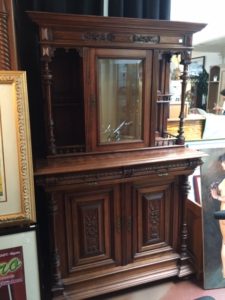 A young 20 year old reader, JE, saw a piece of furniture in a local antique shop, and sent me a photo. She likes it but doesn’t know how to use it in her apartment. The piece is ‘dirt cheap,’ at $200. What is it?
A young 20 year old reader, JE, saw a piece of furniture in a local antique shop, and sent me a photo. She likes it but doesn’t know how to use it in her apartment. The piece is ‘dirt cheap,’ at $200. What is it?
JE, we used to have a dedicated dining room, devoted to the eating experience of a large family. The center of the room contained a large table, with enough space around it for at least six, perhaps more, if grandparents became involved. Furniture existed in a dining room that appeared nowhere else. Furniture designers invented objects that contained things related to dining, expressly large sets of porcelain. These sets of tableware included pieces custom designed for certain foods. This custom of making porcelain containers for special foodstuffs only goes back about 200 years before JE’s birth in 1999.
The interaction between marketplace and furniture grew in the 19th century, the grand era of dining. No respectable hostess in the 19th century never even THOUGHT of serving coffee in a water glass. No water glass ever held red wine. And so on.
Hostesses all over America strove to have a complete even numbered set of porcelain vessels for special foods: a service for 12 people, or 24. If a piece broke, she replaced it because she wanted that consistent even number.
Notice the cabinet doors in the bottom case piece. A hostess used this for stacks of porcelain dishes, perhaps on one side within that cabinet. On the other side, you found silver metal specially created to hold, let us say, vegetables, or mashed potatoes. Trays designed for specific functions, such as caving a joint of meat, lived there, too.
Two drawers surmount the cabinet piece. The drawers might contain a full, even numbered, set of silver flatware, 12 or 24, polished monthly, and hand washed (the only way to wash anything). The OTHER drawer contained the handiwork of little old ladies, hard at work to embroider table napkins. These also needed handwashing and line drying (the only way to dry).
You may ask, why then is the piece mirrored in a way that no face reflected in a glass so low? That mirror reflected a candelabra, lit to enhance the dining experience. A candelabra also needed polishing regularly. In those days a dining experience lasted hours, with many courses.
The shelves on either side of the mirror held regularly used objects necessary for any meal, such as a pickle container, a water jug, a sugar shaker, a bowl for salt. Yes, a bowl, called a saltcellar, held a little spoon for salt. Salt in certain times of American history cost a lot, as did sugar.
Behind the mirror you’ll find another cupboard, a board that held cups, for stacks of teacups and saucers, the beverage of choice for mid-afternoon, served with a little cake. The cake dish came with matching cake plates. Trimmed with real gold, the hostess never thought of putting these little dishes in the dishwasher, or in the microwave. Of course those inventions didn’t exist yet.
Plentiful at one time, carving into solid walnut could be very deep, because the style called for many surfaces to catch dust. Mahogany, a more expensive wood not native to America, came harvested from tropical rainy islands.
The design of the piece indicates a date of 1880, when the style called renaissance revival became popular, a resurgence of Classical taste. Throughout the history of furniture design, we see a battle between the classical elements of Classical design and organic styles like art nouveau. Our taste today for midcentury modern is actually a classical revival of straight lines and angles.
So, JE, if you can spend $200, and you place it somewhere where you serve a meal, you’ll do this piece a favor, because we call it ‘a server.’
I hope this little explanation convinces you that times have changed, and you’re quite right; the sideboard might stay forever unknown to people as young as you, and the forthcoming generations. You see, we just don’t dine anymore.
Pingback: How do I know it’s Hepplewhite? - Elizabeth Appraisals